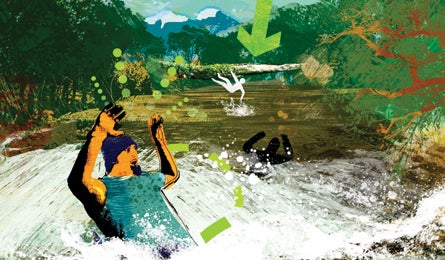Survive This: A Plunge into Raging Whitewater

'Illustration by Tim Marrs'
Predicament
You’re inching across a slick log–over a stream surging with hip-deep water–when you slip and fall into the rapids.
Lifeline
Wriggle out of your pack and float on your back. Face downstream with your knees bent and toes pointing up to avoid snagging underwater obstacles. Raise your head for better vision. Rebound off rocks with your legs, and keep away from sweepers (downed trees). Kick and paddle towards calm water in an eddy or near the shore.
Before crossing a stream, remove bulky layers of clothing. It’s critical that you unbuckle your pack’s hipbelt and sternum strap and loosen the shoulder straps. Ford fast-flowing water facing upstream.
Despite the popular perception, don’t assume that early morning is the best time to cross melt-swollen streams. Variables like river distance and snowpack depth can generate peak flow at any time of day or night, says Jessica Lundquist, an engineering professor at the University of Washington who has studied snowmelt fluctuations in Yosemite. If rushing water is more than knee-deep, wait for slower flow, find a wider, shallower crossing point, or turn around.